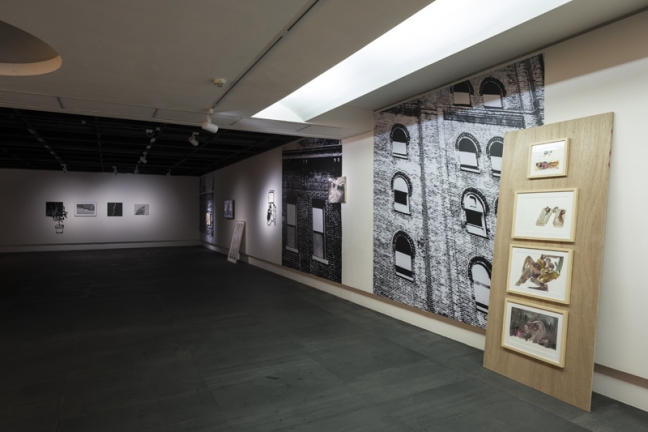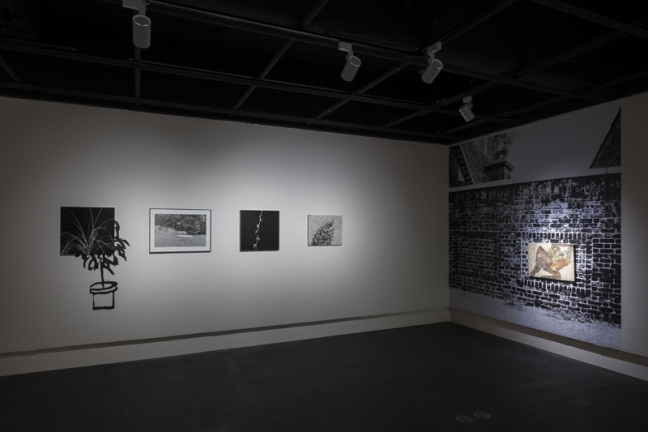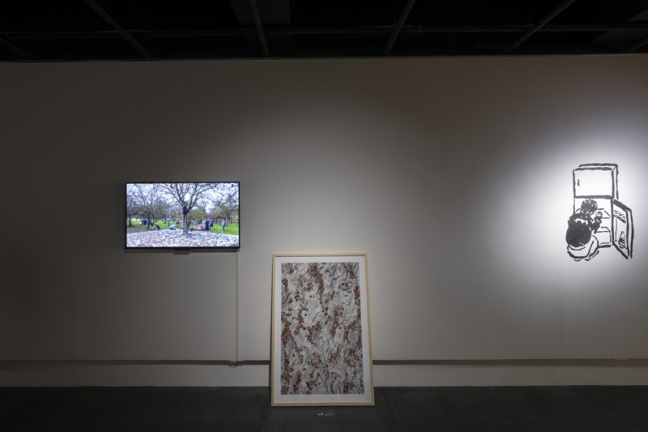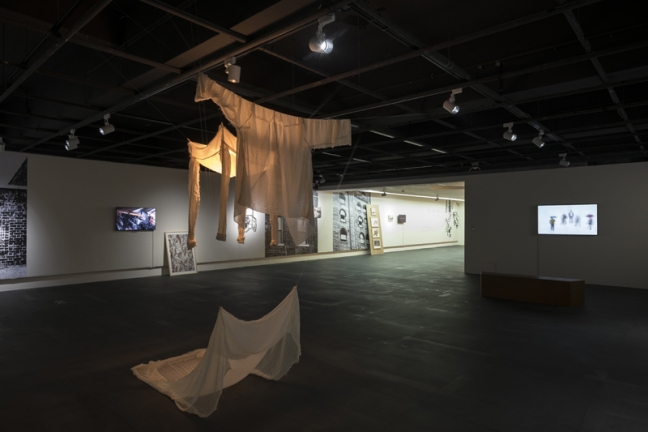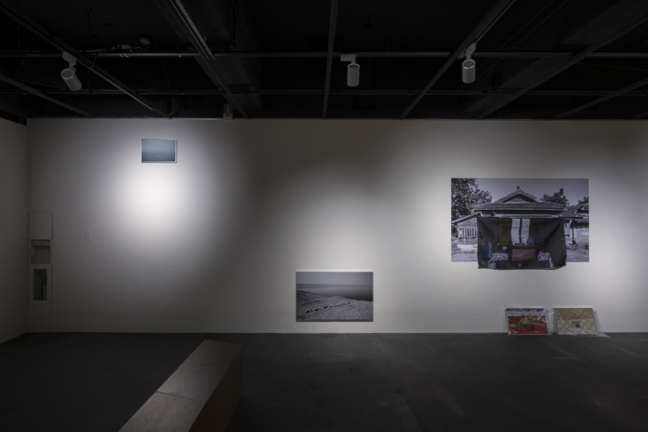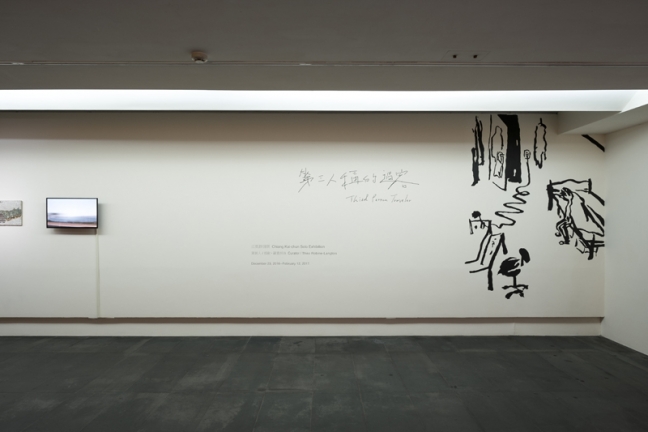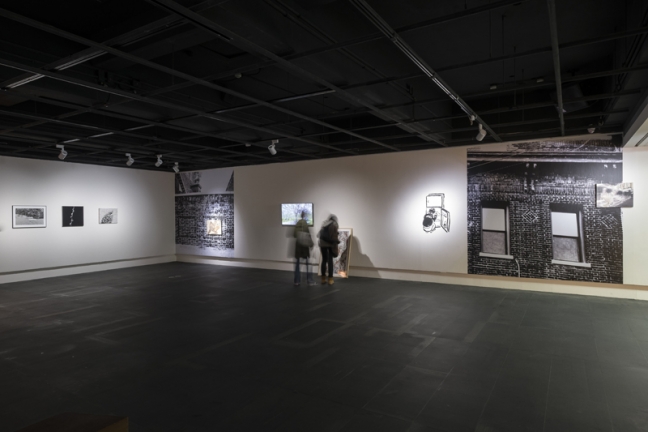Third Person Traveler-Chiang Kai-chun Solo exhibition
2016.12.23~2017.02.12
09:00 - 17:00
Third Person Traveler This is about a person’s life after spending eight years in a foreign land, or perhaps a virtual journey without stepping out of his own room. Chiang Kai-chun’s solo exhibition, titled
Third Person Traveler”, is curated by French curator Théo Robine-Langlois. For this exhibition, the curator wrote a short story to link together the artist’s creative works, video works and paintings. This exhibition is a synthesis of fiction and art; the exhibition itself is a story, taking the audience on a personal journey between reality and the imaginary. The term
third person” reflects the artist’s existence as an outsider while he was studying in France. Being a non-native French speaker and living in a foreign cultural setting have sometimes detached him from what was going on around him. For the artist, the term
third person” possesses another significance: when one work is completed, no change will be made to it and the artist will view his own work as a detached viewer, a third person, or, an outsider. The word
traveler” in the exhibition’s title is inspired by poet Li Bai’s
Preface to A Spring Night’s Banquet at the Peach and Plum Garden”:
Oh, the world is the temporary shelter for all living beings while time sees people as travelers coming and going." The audience may not know exactly whether the artist has been on a trip in person or has just wandered on the Internet. The audience may find themselves enthralled by the semi-asleep, semi-awake ambience generated by the exhibition. With some presage, the curator tries to highlight the lightness of this exhibition. The idea of microhistory, which lies at the core of the exhibition, is inspired by Italian historian Carlo Ginzburg, who did research on microhistory in the 1970s. At this exhibition, each work of art is a reflection of a time in art history. Everyday life has been an important source of inspiration for Chiang’s creative activities and his work is often linked with history or literature. In his work, history is presented through daily life experiences in subtle yet poetic ways. Third Person Travele (Voyage à la troisième personne) Il s’agit de la vie d’une personne après huit ans dans un pays éloigné; ou peut-être qu’il est juste resté dans sa chambre pour voyager sur internet. l’exposition monographique de Chiang Kai-Chun, « Third Person Traveler » est mis en espace par Théo Robine-Langlois, écrivain et commissaire d’exposition français. Pour cette exposition, il a écrit une nouvelle qui relie une sélection de videos, dessins et photographies de Chiang Kai-Chun; l’exposition est elle-même une histoire, qui propose aux spectateurs un voyage personnel entre la réalité et la fiction. L’expression « third person » reflète l’existence de l’artiste comme un étranger quand il étudiait en France. En parlant français sans que ce soit sa langue maternelle et en vivant dans un environnement culturel éloigné du sien, il s’est peu à peu détaché de ce qui se passait directement autour de lui. Pour l’artiste, l’expression « third person » possède aussi une autre signification : quand une oeuvre est achevée, il ne la change pas et voit son propre travail comme un spectateur détaché, une troisième personne, un étranger. Le mot « traveler » dans le titre de l’exposition est inspiré également par le poète Li Bai et son texte « préface à un banquet de printemps dans le verger des pêchers et des pruniers » : « Oh, le monde est un abri temporaire pour tout les êtres vivants pendant que le temps voit les voyageurs venir et repartir. » Les spectateurs ne savent pas si l’artiste a vraiment fait ce voyage ou s’il a juste erré sur internet, quelle importance ? L’exposition plonge le spectateur dans une ambiance entre le sommeil et le réveil, le rêve et la réalité. Partant du travail de Chiang Kai-Chung, Théo Robine-Langlois a traduit sa distance au monde par un accrochage aérien et flottant. L’idée de micro-histoire, qui a servi de cadre conceptuel dans la construction de l’exposition, vient de Carlo Ginzburg qui a inventé ce terme avec trois autres historiens italiens dans les années 70. Dans cette exposition chaque oeuvre parle d’une époque de l’histoire de l’art. La vie de tout les jours est une source d’inspiration pour Chiang Kai-Chung et son travail et souvent lié à l’histoire et la littérature. Cependant, l’histoire arrive toujours par la petite porte, par des expériences du quotidien, de façon subtile et poétique.
Third Person Traveler”, is curated by French curator Théo Robine-Langlois. For this exhibition, the curator wrote a short story to link together the artist’s creative works, video works and paintings. This exhibition is a synthesis of fiction and art; the exhibition itself is a story, taking the audience on a personal journey between reality and the imaginary. The term
third person” reflects the artist’s existence as an outsider while he was studying in France. Being a non-native French speaker and living in a foreign cultural setting have sometimes detached him from what was going on around him. For the artist, the term
third person” possesses another significance: when one work is completed, no change will be made to it and the artist will view his own work as a detached viewer, a third person, or, an outsider. The word
traveler” in the exhibition’s title is inspired by poet Li Bai’s
Preface to A Spring Night’s Banquet at the Peach and Plum Garden”:
Oh, the world is the temporary shelter for all living beings while time sees people as travelers coming and going." The audience may not know exactly whether the artist has been on a trip in person or has just wandered on the Internet. The audience may find themselves enthralled by the semi-asleep, semi-awake ambience generated by the exhibition. With some presage, the curator tries to highlight the lightness of this exhibition. The idea of microhistory, which lies at the core of the exhibition, is inspired by Italian historian Carlo Ginzburg, who did research on microhistory in the 1970s. At this exhibition, each work of art is a reflection of a time in art history. Everyday life has been an important source of inspiration for Chiang’s creative activities and his work is often linked with history or literature. In his work, history is presented through daily life experiences in subtle yet poetic ways. Third Person Travele (Voyage à la troisième personne) Il s’agit de la vie d’une personne après huit ans dans un pays éloigné; ou peut-être qu’il est juste resté dans sa chambre pour voyager sur internet. l’exposition monographique de Chiang Kai-Chun, « Third Person Traveler » est mis en espace par Théo Robine-Langlois, écrivain et commissaire d’exposition français. Pour cette exposition, il a écrit une nouvelle qui relie une sélection de videos, dessins et photographies de Chiang Kai-Chun; l’exposition est elle-même une histoire, qui propose aux spectateurs un voyage personnel entre la réalité et la fiction. L’expression « third person » reflète l’existence de l’artiste comme un étranger quand il étudiait en France. En parlant français sans que ce soit sa langue maternelle et en vivant dans un environnement culturel éloigné du sien, il s’est peu à peu détaché de ce qui se passait directement autour de lui. Pour l’artiste, l’expression « third person » possède aussi une autre signification : quand une oeuvre est achevée, il ne la change pas et voit son propre travail comme un spectateur détaché, une troisième personne, un étranger. Le mot « traveler » dans le titre de l’exposition est inspiré également par le poète Li Bai et son texte « préface à un banquet de printemps dans le verger des pêchers et des pruniers » : « Oh, le monde est un abri temporaire pour tout les êtres vivants pendant que le temps voit les voyageurs venir et repartir. » Les spectateurs ne savent pas si l’artiste a vraiment fait ce voyage ou s’il a juste erré sur internet, quelle importance ? L’exposition plonge le spectateur dans une ambiance entre le sommeil et le réveil, le rêve et la réalité. Partant du travail de Chiang Kai-Chung, Théo Robine-Langlois a traduit sa distance au monde par un accrochage aérien et flottant. L’idée de micro-histoire, qui a servi de cadre conceptuel dans la construction de l’exposition, vient de Carlo Ginzburg qui a inventé ce terme avec trois autres historiens italiens dans les années 70. Dans cette exposition chaque oeuvre parle d’une époque de l’histoire de l’art. La vie de tout les jours est une source d’inspiration pour Chiang Kai-Chung et son travail et souvent lié à l’histoire et la littérature. Cependant, l’histoire arrive toujours par la petite porte, par des expériences du quotidien, de façon subtile et poétique.
Third Person Traveler This is about a person’s life after spending eight years in a foreign land, or perhaps a virtual journey without stepping out of his own room. Chiang Kai-chun’s solo exhibition, titled
Third Person Traveler”, is curated by French curator Théo Robine-Langlois. For this exhibition, the curator wrote a short story to link together the artist’s creative works, video works and paintings. This exhibition is a synthesis of fiction and art; the exhibition itself is a story, taking the audience on a personal journey between reality and the imaginary. The term
third person” reflects the artist’s existence as an outsider while he was studying in France. Being a non-native French speaker and living in a foreign cultural setting have sometimes detached him from what was going on around him. For the artist, the term
third person” possesses another significance: when one work is completed, no change will be made to it and the artist will view his own work as a detached viewer, a third person, or, an outsider. The word
traveler” in the exhibition’s title is inspired by poet Li Bai’s
Preface to A Spring Night’s Banquet at the Peach and Plum Garden”:
Oh, the world is the temporary shelter for all living beings while time sees people as travelers coming and going." The audience may not know exactly whether the artist has been on a trip in person or has just wandered on the Internet. The audience may find themselves enthralled by the semi-asleep, semi-awake ambience generated by the exhibition. With some presage, the curator tries to highlight the lightness of this exhibition. The idea of microhistory, which lies at the core of the exhibition, is inspired by Italian historian Carlo Ginzburg, who did research on microhistory in the 1970s. At this exhibition, each work of art is a reflection of a time in art history. Everyday life has been an important source of inspiration for Chiang’s creative activities and his work is often linked with history or literature. In his work, history is presented through daily life experiences in subtle yet poetic ways. Third Person Travele (Voyage à la troisième personne) Il s’agit de la vie d’une personne après huit ans dans un pays éloigné; ou peut-être qu’il est juste resté dans sa chambre pour voyager sur internet. l’exposition monographique de Chiang Kai-Chun, « Third Person Traveler » est mis en espace par Théo Robine-Langlois, écrivain et commissaire d’exposition français. Pour cette exposition, il a écrit une nouvelle qui relie une sélection de videos, dessins et photographies de Chiang Kai-Chun; l’exposition est elle-même une histoire, qui propose aux spectateurs un voyage personnel entre la réalité et la fiction. L’expression « third person » reflète l’existence de l’artiste comme un étranger quand il étudiait en France. En parlant français sans que ce soit sa langue maternelle et en vivant dans un environnement culturel éloigné du sien, il s’est peu à peu détaché de ce qui se passait directement autour de lui. Pour l’artiste, l’expression « third person » possède aussi une autre signification : quand une oeuvre est achevée, il ne la change pas et voit son propre travail comme un spectateur détaché, une troisième personne, un étranger. Le mot « traveler » dans le titre de l’exposition est inspiré également par le poète Li Bai et son texte « préface à un banquet de printemps dans le verger des pêchers et des pruniers » : « Oh, le monde est un abri temporaire pour tout les êtres vivants pendant que le temps voit les voyageurs venir et repartir. » Les spectateurs ne savent pas si l’artiste a vraiment fait ce voyage ou s’il a juste erré sur internet, quelle importance ? L’exposition plonge le spectateur dans une ambiance entre le sommeil et le réveil, le rêve et la réalité. Partant du travail de Chiang Kai-Chung, Théo Robine-Langlois a traduit sa distance au monde par un accrochage aérien et flottant. L’idée de micro-histoire, qui a servi de cadre conceptuel dans la construction de l’exposition, vient de Carlo Ginzburg qui a inventé ce terme avec trois autres historiens italiens dans les années 70. Dans cette exposition chaque oeuvre parle d’une époque de l’histoire de l’art. La vie de tout les jours est une source d’inspiration pour Chiang Kai-Chung et son travail et souvent lié à l’histoire et la littérature. Cependant, l’histoire arrive toujours par la petite porte, par des expériences du quotidien, de façon subtile et poétique.
Third Person Traveler”, is curated by French curator Théo Robine-Langlois. For this exhibition, the curator wrote a short story to link together the artist’s creative works, video works and paintings. This exhibition is a synthesis of fiction and art; the exhibition itself is a story, taking the audience on a personal journey between reality and the imaginary. The term
third person” reflects the artist’s existence as an outsider while he was studying in France. Being a non-native French speaker and living in a foreign cultural setting have sometimes detached him from what was going on around him. For the artist, the term
third person” possesses another significance: when one work is completed, no change will be made to it and the artist will view his own work as a detached viewer, a third person, or, an outsider. The word
traveler” in the exhibition’s title is inspired by poet Li Bai’s
Preface to A Spring Night’s Banquet at the Peach and Plum Garden”:
Oh, the world is the temporary shelter for all living beings while time sees people as travelers coming and going." The audience may not know exactly whether the artist has been on a trip in person or has just wandered on the Internet. The audience may find themselves enthralled by the semi-asleep, semi-awake ambience generated by the exhibition. With some presage, the curator tries to highlight the lightness of this exhibition. The idea of microhistory, which lies at the core of the exhibition, is inspired by Italian historian Carlo Ginzburg, who did research on microhistory in the 1970s. At this exhibition, each work of art is a reflection of a time in art history. Everyday life has been an important source of inspiration for Chiang’s creative activities and his work is often linked with history or literature. In his work, history is presented through daily life experiences in subtle yet poetic ways. Third Person Travele (Voyage à la troisième personne) Il s’agit de la vie d’une personne après huit ans dans un pays éloigné; ou peut-être qu’il est juste resté dans sa chambre pour voyager sur internet. l’exposition monographique de Chiang Kai-Chun, « Third Person Traveler » est mis en espace par Théo Robine-Langlois, écrivain et commissaire d’exposition français. Pour cette exposition, il a écrit une nouvelle qui relie une sélection de videos, dessins et photographies de Chiang Kai-Chun; l’exposition est elle-même une histoire, qui propose aux spectateurs un voyage personnel entre la réalité et la fiction. L’expression « third person » reflète l’existence de l’artiste comme un étranger quand il étudiait en France. En parlant français sans que ce soit sa langue maternelle et en vivant dans un environnement culturel éloigné du sien, il s’est peu à peu détaché de ce qui se passait directement autour de lui. Pour l’artiste, l’expression « third person » possède aussi une autre signification : quand une oeuvre est achevée, il ne la change pas et voit son propre travail comme un spectateur détaché, une troisième personne, un étranger. Le mot « traveler » dans le titre de l’exposition est inspiré également par le poète Li Bai et son texte « préface à un banquet de printemps dans le verger des pêchers et des pruniers » : « Oh, le monde est un abri temporaire pour tout les êtres vivants pendant que le temps voit les voyageurs venir et repartir. » Les spectateurs ne savent pas si l’artiste a vraiment fait ce voyage ou s’il a juste erré sur internet, quelle importance ? L’exposition plonge le spectateur dans une ambiance entre le sommeil et le réveil, le rêve et la réalité. Partant du travail de Chiang Kai-Chung, Théo Robine-Langlois a traduit sa distance au monde par un accrochage aérien et flottant. L’idée de micro-histoire, qui a servi de cadre conceptuel dans la construction de l’exposition, vient de Carlo Ginzburg qui a inventé ce terme avec trois autres historiens italiens dans les années 70. Dans cette exposition chaque oeuvre parle d’une époque de l’histoire de l’art. La vie de tout les jours est une source d’inspiration pour Chiang Kai-Chung et son travail et souvent lié à l’histoire et la littérature. Cependant, l’histoire arrive toujours par la petite porte, par des expériences du quotidien, de façon subtile et poétique.
Chiang Kai-chun is a mosaic craftsman, director and photographer, who travels frequently. He discovered experimental film during his study in École Nationale Supérieure d’Arts de Paris-Cergy (ENSAPC) and Le Fresnoy, Studio National des arts contemporains in France. His works tend to be closely related to craftsmanship. Digital pixels and traditional mosaic have been his research topics for years. Chiang Kai-chun has been learning mosaic production in Jordan and Paris since 2012, and acquired a diplôme national supérieur d’expression plastique during his stay in Paris. He has received creation grants from multiple institutions, including the Contemporary Art Foundation (Taipei, Taiwan, National Culture and Arts Foundation (Taiwan), Cloud Gate Dance Foundation (Taiwan), and Centre France-Asie (Paris). His works have been displayed in the Taipei Fine Arts Museum, Kuandu Museum of Fine Arts (Taipei), Cité de l’Architecture et du Patrimoine (Paris), and Le Fresnoy-studio national des arts contemporains (France). Chiang Kai-chun has also been invited to present his films at the International Animation Film Festival Geneva and Glasgow Short Film Festival. In addition, in 2016, He was selected by the Ministry of Culture (Taiwan) and the Department of Cultural Affairs (Taipei) to stay in New York and Tokyo as a visiting artist. He is currently a full-time artist.
Chiang Kai-chun is a mosaic craftsman, director and photographer, who travels frequently. He discovered experimental film during his study in École Nationale Supérieure d’Arts de Paris-Cergy (ENSAPC) and Le Fresnoy, Studio National des arts contemporains in France. His works tend to be closely related to craftsmanship. Digital pixels and traditional mosaic have been his research topics for years. Chiang Kai-chun has been learning mosaic production in Jordan and Paris since 2012, and acquired a diplôme national supérieur d’expression plastique during his stay in Paris. He has received creation grants from multiple institutions, including the Contemporary Art Foundation (Taipei, Taiwan, National Culture and Arts Foundation (Taiwan), Cloud Gate Dance Foundation (Taiwan), and Centre France-Asie (Paris). His works have been displayed in the Taipei Fine Arts Museum, Kuandu Museum of Fine Arts (Taipei), Cité de l’Architecture et du Patrimoine (Paris), and Le Fresnoy-studio national des arts contemporains (France). Chiang Kai-chun has also been invited to present his films at the International Animation Film Festival Geneva and Glasgow Short Film Festival. In addition, in 2016, He was selected by the Ministry of Culture (Taiwan) and the Department of Cultural Affairs (Taipei) to stay in New York and Tokyo as a visiting artist. He is currently a full-time artist.
